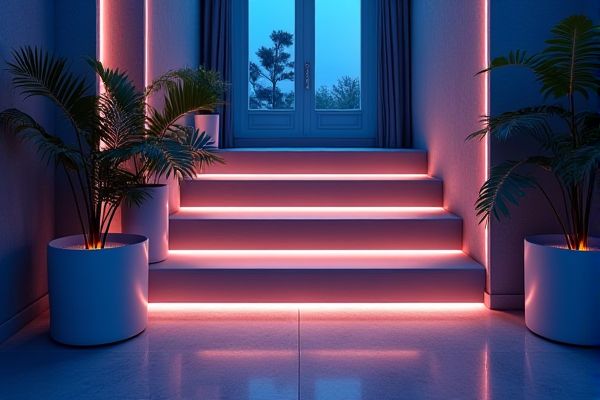
LED strip lighting offers versatile, continuous illumination with customizable colors and brightness, ideal for enhancing ambiance along walls or ceilings. Step lighting provides focused safety by illuminating stair edges and pathways, reducing trip hazards; explore the full article to understand which option best suits Your space and needs.
Table of Comparison
| Feature | LED Strip Lighting | Step Lighting |
|---|---|---|
| Purpose | Decorative and ambient lighting | Illuminates steps for safety |
| Installation Location | Under cabinets, ceilings, walls | Along stair risers or tread edges |
| Light Source | Flexible LED strips | Recessed or surface-mounted LED fixtures |
| Brightness | Low to medium, adjustable | Medium to high, focused |
| Energy Efficiency | Highly energy-efficient | Energy-efficient but higher usage per fixture |
| Durability | Depends on IP rating; often indoor | Robust for outdoor and high-traffic areas |
| Aesthetic Impact | Modern, customizable colors | Subtle, functional lighting |
| Cost | Lower initial cost | Higher cost due to fixtures and installation |
Introduction to LED Strip Lighting and Step Lighting
LED strip lighting offers flexible, energy-efficient illumination with customizable colors and brightness, making it ideal for accent lighting, under-cabinet applications, and creative design projects. Step lighting provides focused, low-level illumination specifically designed to enhance safety and visibility on stairways, often featuring recessed fixtures or wall-mounted units to prevent glare. Both lighting types integrate seamlessly into modern architectural designs, improving aesthetics and functionality while reducing energy consumption.
Key Differences Between LED Strip Lighting and Step Lighting
LED strip lighting provides continuous, flexible illumination with high brightness levels and customizable color options, ideal for accentuating architectural features or creating ambient effects. Step lighting is specifically designed for safety, offering focused, low-level illumination on staircases or pathways to prevent accidents and enhance visibility. While LED strips prioritize aesthetic versatility and energy efficiency, step lighting emphasizes durability, targeted brightness, and compliance with safety standards.
Aesthetic Appeal: Design Flexibility and Visual Impact
LED strip lighting offers exceptional design flexibility with customizable colors, brightness levels, and seamless installation along various surfaces, creating a continuous, modern glow that enhances architectural features and interior ambiance. Step lighting provides targeted illumination with focused beams that enhance safety while delivering subtle visual accents, ideal for highlighting stair edges and pathways. The continuous light effect of LED strips creates a striking, uniform aesthetic, whereas step lights offer discrete points of emphasis, making each suitable for different design intents and spatial dynamics.
Installation Requirements and Process Comparison
LED strip lighting requires a flat, clean surface for adhesive backing installation, making it ideal for continuous illumination along edges or under cabinets with minimal wiring complexity. Step lighting involves precise placement within stair risers or walls, requiring electrical junction boxes and more intricate wiring to ensure safety and compliance with building codes. Your choice depends on whether you prefer the straightforward adhesive application of LED strips or the professional installation and structural integration needed for step lighting.
Energy Efficiency and Power Consumption
LED strip lighting offers superior energy efficiency by utilizing low-voltage DC power and consuming significantly less electricity compared to traditional step lighting. Step lighting often uses incandescent or halogen bulbs, which have higher wattage and generate more heat, resulting in increased power consumption. Choosing LED strip lighting reduces energy costs and minimizes environmental impact due to its longer lifespan and lower energy demands.
Safety Considerations for Stairs and Walkways
LED strip lighting provides continuous illumination that enhances visibility along stairs and walkways, reducing the risk of trips and falls by clearly outlining each step. Step lighting, installed at each stair riser or sidewall, offers focused light on individual steps, improving depth perception and safety in low-light conditions. Your choice should consider the installation environment, desired brightness, and maintenance ease to ensure optimal safety.
Cost Analysis: Upfront and Long-Term Expenses
LED strip lighting typically has a lower upfront cost compared to step lighting due to simpler installation and fewer materials required. Long-term expenses for LED strips remain minimal because of their energy efficiency and extended lifespan, reducing maintenance and replacement frequency. Step lighting often involves higher initial investment for professional installation and may incur increased maintenance costs over time due to exposure and wiring complexity.
Durability and Maintenance Needs
LED strip lighting offers high durability with its flexible design and protective coatings that resist moisture and dust, requiring minimal maintenance over time. Step lighting is typically encased in robust fixtures designed to withstand impact and harsh outdoor conditions, but may need more frequent cleaning to maintain optimal brightness and ensure safety. Both lighting options provide long-lasting performance, but LED strips excel in low-maintenance applications while step lights prioritize durability in demanding environments.
Application Scenarios: Best Use Cases
LED strip lighting excels in creating flexible accent lighting for indoor spaces such as kitchens, living rooms, and retail displays, offering customizable colors and brightness. Step lighting is best suited for safety and guidance on stairs, pathways, and outdoor steps, providing focused illumination to prevent accidents. Your choice depends on whether you need ambient enhancement or functional safety lighting in a specific area.
Conclusion: Choosing the Right Lighting Solution
LED strip lighting offers versatile, energy-efficient illumination ideal for accentuating spaces with customizable colors and brightness, while step lighting provides targeted safety by illuminating staircases and pathways to prevent falls. Your choice depends on whether you prioritize aesthetic flexibility or functional safety, as both solutions enhance visibility but serve different purposes. Evaluating the specific environment and lighting goals ensures the most effective and stylish option for your project.
 homyna.com
homyna.com